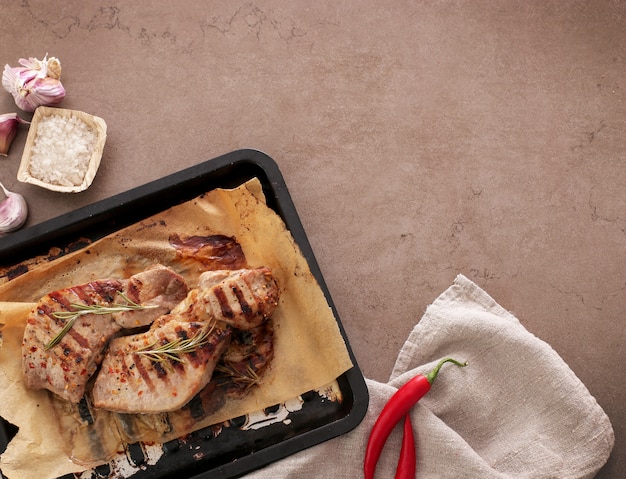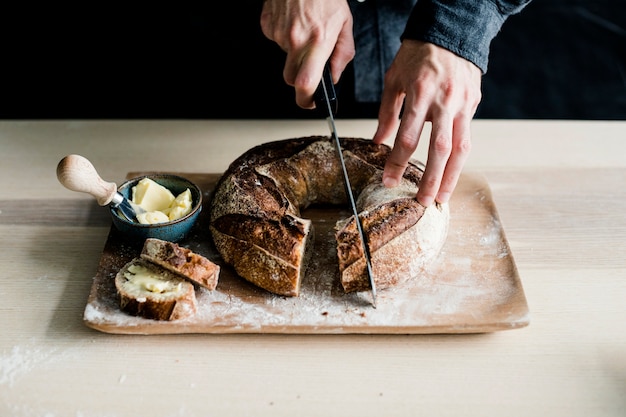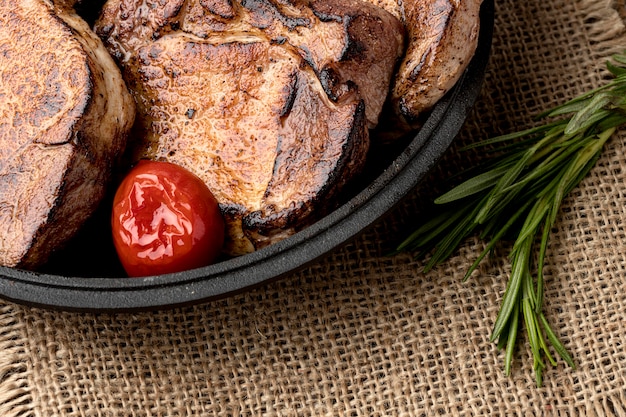I'm a firm believer that a perfectly cooked steak is an art form. And when it comes to steak, filet mignon holds a special place in my heart. It's the epitome of tenderness, boasting a rich flavour that melts in your mouth. But I've certainly had my fair share of steak disasters – dry, overcooked, or undercooked disasters. It's a journey, you know? But through years of trial and error, I've finally discovered the secret to consistently achieving that juicy, perfectly cooked filet mignon every time. So, let's dive in and unlock the secrets to a truly exceptional steak experience!
(Part 1) Choosing the Right Filet Mignon: The Foundation of a Great Steak

It all begins with selecting the right cut of meat. Filet mignon is a premium cut, so you want to ensure you're getting the best possible quality. This is where the magic starts.
The Cut Matters: Tenderloin Perfection
Filet mignon comes from the tenderloin, the most tender part of the beef. This makes it naturally tender, practically melting in your mouth. When I'm at the butcher counter, I always look for a filet mignon that's at least 1-inch thick. That extra thickness ensures a nice, even cook and allows for a succulent, juicy steak. And, of course, I always ask the butcher to trim off any excess fat.
Marbling: The Secret to Juicy Flavor
Here's a tip that will take your filet mignon to the next level: look for marbling. Those streaks of fat throughout the meat are crucial. They add a delightful richness and keep the steak moist during cooking. The more marbling you see, the more flavourful and juicy the steak will be.
Freshness: The Crucial Ingredient
As with any meat, freshness is key. You want a filet mignon that's bright red and firm to the touch. Avoid any that looks slimy or has an off smell. This will make a huge difference in the final flavour and texture of your steak.
(Part 2) Prepping the Filet Mignon: Bringing Out the Best

You've got your perfect filet mignon. Now, it's time to prepare it for its star turn. These steps may seem simple, but they're crucial for achieving that perfect cook.
Pat It Dry: The Foundation of Even Browning
The first step is to pat the filet mignon dry with paper towels. This might seem like a small detail, but it's essential. It ensures even browning and helps create a delicious, crispy crust. I've learned the hard way that skipping this step results in a pale, less flavorful steak.
Seasoning: The Art of Enhancing Flavour
Next comes the seasoning, and this is where you can really let your creativity shine. I'm a big fan of keeping it simple with just a good sprinkle of salt and freshly ground black pepper. It allows the natural flavour of the filet mignon to truly shine. But if you're feeling adventurous, you can add other seasonings like garlic powder, onion powder, or paprika. Just remember, a little goes a long way. You don't want to overwhelm the delicate taste of the steak.
Here's a game-changer: salt your steak at least 30 minutes before cooking. This allows the salt to penetrate the meat, drawing out moisture and helping the steak cook more evenly. Trust me, it's worth the extra time.
(Part 3) Cooking the Filet Mignon: Mastering the Oven Technique

Now, for the main event! Cooking the filet mignon. This is where you'll put your newfound knowledge to the test.
Preheat the Oven: The Key to Even Cooking
Always preheat your oven to 400 degrees Fahrenheit (200 degrees Celsius). This is crucial for ensuring that the steak cooks evenly and quickly. I've learned that not preheating the oven can lead to an unevenly cooked, potentially tough steak. It's a simple step but a vital one.
Searing: Achieving a Delicious Crust
The secret to a juicy, flavorful filet mignon lies in searing it before baking. This creates a delicious, crispy crust that locks in the juices and adds an extra layer of flavor. My favourite tool for searing? A cast-iron skillet. It gets incredibly hot and distributes the heat evenly. But a heavy-bottomed pan will work just as well.
Heat the skillet over high heat and add a tablespoon of oil, like olive oil or grapeseed oil. Let the oil get really hot before adding the steak. This is where the magic happens. Place the filet mignon in the hot skillet and sear for 2-3 minutes on each side. You’ll want to see a beautiful, golden-brown crust developing. Resist the urge to move it around too much. Let it form a lovely crust before flipping it.
Baking: Bringing the Steak to Perfection
Once your steak has a delicious crust, transfer it to a baking sheet. I typically line my baking sheet with parchment paper for easy cleanup. Now, it's time to bake. Bake the filet mignon in the preheated oven for 10-12 minutes for medium-rare, 15-18 minutes for medium, and 20-25 minutes for medium-well. You can adjust the baking time slightly depending on the thickness of your steak.
Using a meat thermometer is a must! The USDA recommends an internal temperature of 145 degrees Fahrenheit (63 degrees Celsius) for medium-rare.
(Part 4) Resting: The Final Touch for a Juicy Steak
The final step before serving? Resting. It might seem tempting to dig into that perfectly cooked steak right away, but patience is key. Let the steak rest for 10-15 minutes before slicing. This allows the juices to redistribute throughout the meat, resulting in a more tender and flavorful steak. It’s a crucial step to ensuring that the meat is juicy and delicious.
While the steak is resting, you can prepare your favorite side dishes. I love serving my filet mignon with mashed potatoes, asparagus, or a simple salad.
(Part 5) Mastering the Doneness: Finding Your perfect steak
One of the biggest challenges for home cooks is mastering the art of cooking a steak to the perfect doneness. But don't worry, it's easier than you might think. There are a couple of methods you can use.
The Touch Test: A Simple Guide to Doneness
The first method is the touch test. It involves pressing the center of the steak with your finger. Here's a quick guide to the touch test:
| Doneness | Touch |
|---|---|
| Rare | Soft and springy, like a marshmallow |
| Medium-rare | Slightly firmer, like a soft nose |
| Medium | Firm, like a chin |
| Medium-well | Very firm, like a forehead |
| Well-done | Rock-hard, like a board |
While the touch test is a helpful guide, it's not foolproof. It's best used in conjunction with a meat thermometer, especially if you're new to cooking steak.
The Meat Thermometer: Precision for Perfect Results
If you want to be absolutely sure about the doneness of your steak, a meat thermometer is a must. I always recommend using a digital meat thermometer. It's quick, accurate, and gives you peace of mind.
Here’s a handy guide to the internal temperatures for different levels of doneness:
- Rare: 125-130 degrees Fahrenheit (52-54 degrees Celsius)
- Medium-rare: 130-135 degrees Fahrenheit (54-57 degrees Celsius)
- Medium: 135-140 degrees Fahrenheit (57-60 degrees Celsius)
- Medium-well: 140-145 degrees Fahrenheit (60-63 degrees Celsius)
- Well-done: 145-160 degrees Fahrenheit (63-71 degrees Celsius)
If you're new to cooking steak, I recommend starting with medium-rare. It's a classic for a reason, and the steak will be tender and juicy.
(Part 6) Elevating Your Steak Game: Sauces and Sides
Once your perfect filet mignon is resting, it's time to think about the finishing touches: sauces and sides. These add another dimension of flavour and richness to the meal.
Sauce it Up: Adding a Finishing Touch of Flavor
A good sauce can take your steak from good to absolutely divine. Here are a few of my go-to sauces for filet mignon:
- Béarnaise Sauce: This classic sauce is made with butter, egg yolks, white wine, and tarragon. It's rich, creamy, and pairs perfectly with the delicate flavour of filet mignon. It adds a touch of elegance to any steak dinner.
- Red Wine Sauce: A simple red wine sauce made with red wine, shallots, garlic, and herbs is a quick and easy way to elevate your steak. The tangy, slightly sweet flavour complements the richness of the filet mignon.
- Peppercorn Sauce: This tangy and spicy sauce is made with black peppercorns, butter, and cream. It adds a delightful kick to your filet mignon, especially if you like a bit of heat.
- Mushroom Sauce: For a heartier sauce, you can try a mushroom sauce. It's made with mushrooms, butter, and wine. It's delicious and satisfying, and complements the richness of the steak. It's a classic combination that never fails to impress.
If you're feeling adventurous, you can even try making your own sauce from scratch. There are endless possibilities for sauces, and you can find recipes online or in cookbooks. Experiment with different herbs and spices to create your own unique sauce.
The Perfect Sides: Completing Your Meal
The right side dish can make or break your steak dinner. Here are a few of my favourites that pair well with filet mignon:
- Mashed Potatoes: Creamy, buttery mashed potatoes are a classic accompaniment to steak. I like to use yukon gold potatoes and add a bit of heavy cream and butter for a rich and indulgent side dish. They provide a comforting balance to the rich flavour of the steak.
- Asparagus: fresh asparagus roasted or grilled with a little olive oil and salt is a simple and elegant side dish that complements the richness of the steak. It adds a refreshing, bright flavour to the meal.
- Roasted Vegetables: Roasted vegetables, like Brussels sprouts, carrots, or squash, add colour and texture to your plate. They provide a variety of flavours and textures, making your meal more interesting.
- Salad: A fresh salad with a light vinaigrette can help balance the richness of the steak. It adds a light and refreshing element to the meal, making it feel more balanced and complete.
(Part 7) My Top Tips for Filet Mignon Success: Lessons Learned
Here are a few extra tips to help you make the best filet mignon ever:
- Don't overcrowd the skillet. If you're cooking more than one filet mignon, make sure you don't overcrowd the skillet. This will prevent the steak from searing properly and could lead to uneven cooking. Give each steak its own space to get that beautiful crust.
- Use a meat thermometer. A meat thermometer is a must-have for any serious cook. It takes the guesswork out of cooking steak and ensures that it's cooked to your desired doneness. It's a simple tool that can make a big difference.
- Rest the steak before slicing. This is a crucial step that will help prevent the juices from running out when you cut into the steak. It's worth the extra time for a juicier, more flavorful steak.
- Don't overcook the steak. Overcooked steak is tough and dry. Aim for medium-rare or medium for the best flavour and texture. Enjoy the steak at its prime.
- Enjoy! The most important tip is to enjoy your perfectly cooked filet mignon.
(Part 8) FAQs: Your Questions, Answered
Let's answer some common questions about cooking filet mignon.
1. How Long Should I Sear the Steak?
Sear the steak for 2-3 minutes per side, or until you see a nice, brown crust. You want to get a good sear, but you don't want to overcook the steak.
2. What Temperature Should I Bake the Steak at?
Bake the filet mignon in a preheated oven at 400 degrees Fahrenheit (200 degrees Celsius).
3. How Long Should I Rest the Steak?
Rest the steak for 10-15 minutes before slicing. This allows the juices to redistribute throughout the meat, resulting in a more tender and flavorful steak.
4. Can I cook filet mignon on the Grill?
Absolutely! You can cook filet mignon on the grill. Just make sure to heat your grill to medium-high heat and cook the steak for 4-6 minutes per side. Make sure to grill over direct heat for a lovely char.
5. What Happens If I Overcook the Steak?
If you overcook the steak, it will be tough and dry. It's important to cook steak to the desired doneness and not overcook it. Pay attention to the internal temperature and use a meat thermometer to ensure you achieve the perfect cook.
Now, go forth and conquer the world of filet mignon! Remember, with a little practice and patience, you can create a delicious and memorable steak experience at home.
Everyone is watching

Corn on the Cob: The Ultimate Guide to Perfectly Cooked Ears
Healthy MealsAh, corn on the cob. Just the name evokes images of sunny days, barbecues, and that sweet, juicy flavour that ...

Perfect Pork Roast Oven Cooking Time: A Guide to Delicious Results
Healthy MealsThere's something truly satisfying about a perfectly roasted pork. The aroma alone is enough to make your mout...

Ham Cooking Time: How Long to Bake, Smoke, or Boil a Delicious Ham
Healthy MealsAh, ham. It's a classic, isn't it? A real crowd-pleaser, especially around holidays. And when done right, it'...

Scallops: The Ultimate Guide to Perfect Cooking
Healthy MealsAh, scallops. Those delicate, sweet, and utterly delicious morsels of the sea. They hold a special place in my...

Spaghetti Squash: The Ultimate Guide to Cooking and Serving
Healthy MealsRemember that time you saw spaghetti squash at the supermarket, looking all bumpy and strange, and thought, "W...
